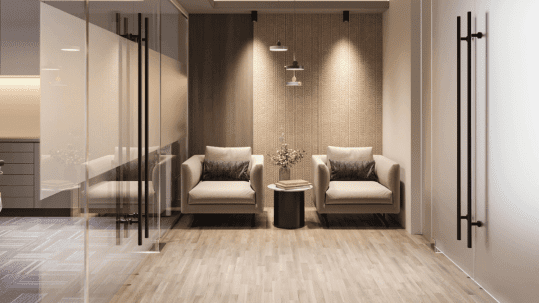Offices need room to inspire and influence their staff, and growing businesses require spaces that are allowed to grow and evolve with them as the business landscape adapts over time.
One of the first questions you will inevitably ask yourself when considering moving into a new office space, or establishing your first business location, will be: how much office space does my company need?
Sometimes this can mean going beyond square footage calculations and asking bigger, more complex questions to assess how big the office will need to be to accommodate the business and help meet organizational goals. In this post, we’ll look at some of the best ways to determine how much office space your company will need.
Key Questions
Deliberation and projection play a major role in determining the size of office you’ll need to meet your organizational goals. There are many key factors that help plan the size of the office you’ll need, including:
- What’s the smallest space the company could utilize?
- Is the company past this minimum size now?
- Is downsizing feasible?
- How will future growth and development of the company affect employee satisfaction and productivity?
- Is there potential for a company merger, acquisition, or closure?
- How does current and future technology play a role in how well the company and its employees can perform?
- Will technological trends impact use of space in the future?
- Should space-orientated considerations play a role in required office size?
- Non assigned seating, open concept seating, brainstorm/collaboration spaces, multipurpose rooms, etc.
- How will the size of the office affect potential relocation or refurbishment efforts?

Industries Differ
The overarching trend in modern office design dictates more open spaces with fewer private spaces. Open space can mean a higher density of employees per square foot, but employee space numbers vary greatly from industry to industry.
Creative offices like design houses and production offices, as well as law firms typically require more square footage per employee – say, 300 square feet or more – whereas news and journalism dependant businesses can corral many writers and content producers into one large space – sometimes as low as 125-175 square feet per employee. As an aside to physical space requirements, different industries also require different spaces; a law firm may need additional conference rooms, private offices, and filing rooms, while a call center can easily accommodate a large open room with few obstructions to maintain productivity.
Per Employee
Your company real estate agent or workspace manager will be able to help find an approximate square footage requirement for your business based on the number of employees that will use the space, and the square footage available. On top of square footage, the number of permanent office spaces and other types of shared rooms will be required to factor into the search for the perfect sized office.
Some industries will employ a specific number of square feet of space required for each employee, therefore dictating the minimum space required to accommodate a specific workforce. For example, by dividing the total area of the office by the number of employees a company has, may find that the space gives, say, 100 square feet per employee (a requirement of the Building Code of Australia).
As a general rule, as cited by the Balance:
Employees Requiring Offices
- President (400 sq. ft.)
- Vice Presidents (200 sq. ft.)
- Managers (150 sq. ft.)
Small Space Employees
- Engineers (175 sq. ft.)
- Accountants (150 sq. ft.)
- Secretaries/administrators (125 sq. ft.)
- Customer Service Reps (125 sq. ft.)
- Programmers/developers (125 sq. ft.)
Open Concept Employees
- Data Entry (125 sq. ft.)
- Clerks (125 sq. ft.)
- Temporary Employees (100 sq. ft.)
Other Space Requirements
- File Room (200 sq. ft.)
- Storage Room or Library (200 sq. ft
- Mail Room (125 sq. ft.)
- Work Room (125 sq. ft.)
- Reception Area (100 sq. ft.)
- Lunch/Break Room (75 sq. ft.)
- Conference Room (50 sq. ft.)
- Other Specialty Areas (size varies depending upon usage)
Accounting for Buyers, Lease Holders & Future Growth
Buying a new office building, or signing a new lease agreement or an extension of an existing lease can mean that a company expecting a considerable degree of growth could be attached to a location that doesn’t fit their needs as an organization for years. Companies should always consider adding a minimum of 10-20% increase to the current square footage of their pre-existing space to accommodate for any projected future growth when considering relocation, or lease renewal discussions.
The cost of terminating a lease prematurely thanks to detrimental space constraints and slowed company growth can offset the progress you’ve made as a company, whereas having space readily available will encourage that growth to continue hassle-free.
—
Offices can become the identity of an organization, in terms of a face value and/or curb appeal, as well as how employees and clients may perceive the company.
Accurately determining the required size of office a company will need is paramount to eliminating issues of rapid growth and organizational efficiency. Just as a mechanic needs to the right tools to do a great job, companies also require the right spaces to maximize their successes.






